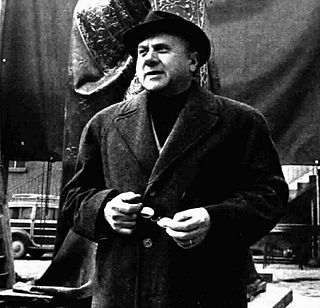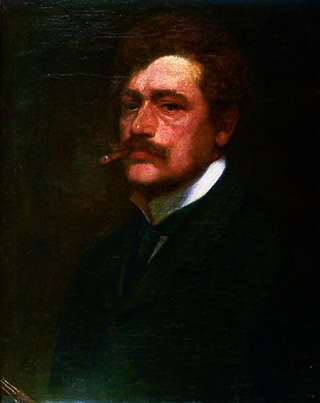Related Research Articles

Giovanni Fattori was an Italian artist, one of the leaders of the group known as the Macchiaioli. He was initially a painter of historical themes and military subjects. In his middle years, inspired by the Barbizon school, he became one of the leading Italian plein-airists, painting landscapes, rural scenes, and scenes of military life. After 1884, he devoted much energy to etching.

Francesco Messina was an Italian sculptor of the 20th century.

Enrico Coleman was an Italian painter of British nationality. He was the son of the English painter Charles Coleman and brother of the less well-known Italian painter Francesco Coleman. He painted, in oils and in watercolours, the landscapes of the Campagna Romana and the Agro Pontino; he was a collector, grower and painter of orchids. Because of his supposedly Oriental air, he was known to his friends as "Il Birmano", the Burmese.
Cesare Bartolena was an Italian painter, mainly of military or battle scenes.
Eugenio Tano was an Italian painter.

Ulvi Liegi was an Italian painter and printmaker. Part of the Post-macchiaioli movement, he painted various cityscapes of Livorno and depictions of Livornese daily life.
Rocco Lentini was an Italian painter, noted for directing the team responsible for the ceiling decorations of the Teatro Massimo in Palermo.

Giuseppe Amisani was an Italian portrait painter of the Belle Époque.

Alfredo Luxoro (1859–1918) was an Italian painter, mainly of landscapes, genre, and orientalist themes.
Enrico Reycend was an Italian painter, mainly of landscapes and vedute.

Raffaello Gambogi was an Italian painter, mainly of urban landscapes and genre scenes.
Giuseppe Sartori was an Italian painter, painting mainly land and seascapes, both urban vedute and rural.

Llewelyn Lloyd was a British-Italian painter, belonging to the Post-Macchiaioli movement.
Benvenuto Benvenuti was an Italian painter, mainly of landscapes.

Raffaele Tafuri (1857–1929) was an Italian painter. He was born on January 27, 1857, in Salerno. He died in 1929 in Venice.
Mario Borgiotti was an Italian painter and art collector.
Ferrucio Pagni was a French-Italian painter active mainly painting sacred subjects in a late-Mannerist style in Siena, Tuscany, Italy.

Onorato Carlandi was an Italian painter, mainly of watercolors of Rome, the surrounding countryside and of Great Britain. He was married to the painter, Lina Haverty (?-1950), daughter of the Irish historian and journalist, Martin Haverty.

Giovanni Philippone was an Italian painter and sculptor.
Michele Guerrisi was an Italian sculptor, painter and writer.
References
- ↑ Galleria Athena Archived 2014-02-06 at archive.today biography.
- ↑ Sources: AA.VV., Ottocento. Numero 20. Cronache dell'arte italiana dell'Ottocento, Giorgio Mondatori & Associati, Milano 1921. Raffaele Monti e Giuliano Matteucci ( a cura di), I Postmacchiaioli, Edizioni De Luca, Rome 1994. Quoted in Pinacoteca Livorno Archived 2018-05-22 at the Wayback Machine short biography.
- ↑ Galleria Athena Archived 2014-02-06 at archive.today biography.